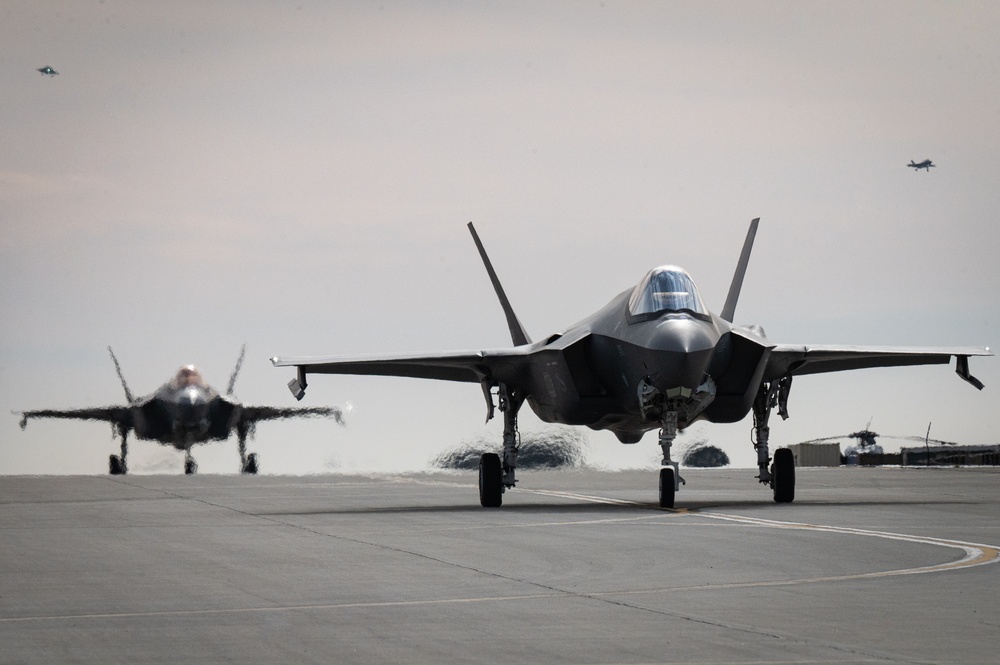The 350th Spectrum Warfare Wing recently participated in the U.S. Air Force Warfare Center’s Bamboo Eagle 25-1 exercise, developing and readying Airmen to operate against adversaries on short notice in a contested and dynamic electromagnetic operating environment.
Bamboo Eagle provides an advanced and realistic training environment to prepare the U.S. and allied forces for evolving demands of modern warfare, allowing warfighters to increase combat readiness and respond quickly to threats using agile combat employment.
In modern combat, blue and red forces are expected to continuously adapt and respond to each other’s electromagnetic spectrum operations, known as EMSO, creating a need for the 350th SWW to swiftly deliver cutting-edge capabilities to warfighters to overcome adversarial challenges.
During BE 25-1, the 350th assessed Blue Force EMSO integration and tested the proficiency of operating within a multi-level security infrastructure. The goal was to convert data from multiple platforms into a common data format.
“Assessments are absolutely critical,” said U.S. Air Force Lt. Gen. Michael Koscheski, deputy commander of Air Combat Command, during a recent visit to the wing. “If we are going to be a learning organization and gain from the investments made during BE, we must prioritize assessments. Otherwise, we would have nothing to feed back into our systems, processes, and warfighters.”
The 17th Electronic Warfare Squadron, which focuses on verifying the effectiveness of air operations in the electromagnetic spectrum, led the wing’s assessment effort.
The squadron participated in BE 24-3 last year, learning key lessons to improve tactics, techniques, and procedures, or TTPs, which they incorporated into this iteration of the exercise.
“The first [Bamboo Eagle] we participated in, we only deployed personnel to one location,” said Lt. Col. C. Ryan Cox, 17th EWS commander. “A valuable lesson learned was that if we wanted to provide the most accurate findings to leadership, we need teams disbursed as broadly as necessary.”
The 17th observed multiple aspects of EMSO during the exercise, including the integration in joint planning; command and control functions; inclusion of EMS-targets and tasks affecting long range kill chains during Air Tasking Order generation cycle; integration of EMSO effects in the live, virtual, and constructive portions of the exercise; and the efficacy of radio frequency signature management.
To provide the most accurate findings, the assessments were conducted at four locations: Joint Battle Watch, Nellis AFB, Nevada; Air Operations Center, Hurlburt Field, Florida; Distributed Mission Operations Center, Kirtland AFB, New Mexico; and ACE spoke, March Air Reserve Base, California.
Each location had several assessment objectives, but all locations shared one: assess Blue Force EMSO effectiveness in coordinating, integrating, and executing EW effects as an essential element of supporting joint all-domain operations, or JADO, especially when operating within a contested and congested environment.
The assessments are crucial because they can shape EW capability requirements and large force TTPs that contribute to the development of combatant command operations plans and our ability to be responsive and proactive in the electromagnetic spectrum.
Besides assessments, the wing’s priority for BE 25-1 centered around the 850th Spectrum Warfare Group, which led the testing of an MLS system that facilitated cross-platform analysis of crowd sourced flight data, or CSFD, in a single location.
The 350th analyzed data from several aircraft with differing classification levels in one central location, driving capabilities for the warfighter at the speed of relevance.
“MLS enhances the ability to execute missions effectively,” said Shannon Conklin, 850th SWG chief engineer. “This new technology gives us the capability to bring everything together in one place, allowing us to meet timelines and requirements.”
During BE 25-1, the 850th collected CSFD from multiple aircraft in different data formats and at multiple classification levels, worked to transform that data into a common data format, and ingested that data into a security infrastructure called Nucleus, which wing engineers could access.
“Bringing the data together allows the aircraft to inform each other,” said Casey Fulton, CSFD lead. “It provides us more information than if we analyzed the systems alone, and it helps us learn more about the [EMSO] environment.”
Previously, the group demonstrated cross-platform analysis on an MLS system using a different security infrastructure called Morpheus. By analyzing the MLS systems Morpheus and Nucleus, the wing can make determinations on how to best move forward.
“Both technologies are used to co-locate and analyze data,” Conklin said. “Both can identify discrepancies and improve mission data products for the warfighter.”
The MLS test and EMSO assessments in BE 25-1 mark a milestone in exercise participation as the wing works to evolve EMSO capabilities in support of joint and coalition partners. Exercises like BE 25-1 provide a combat-representative battlespace necessary to train, test and assess the Combat Air Force’s ability to execute EW in a contested, congested, and constrained electromagnetic spectrum.
| Date Taken: | 02.24.2025 |
| Date Posted: | 02.24.2025 21:46 |
| Story ID: | 491426 |
| Location: | EGLIN AIR FORCE BASE, FLORIDA, US |
| Web Views: | 26 |
| Downloads: | 0 |
PUBLIC DOMAIN

This work, 350th SWW assesses EW integration, data at Bamboo Eagle 25-1, by SrA Anna Smith, identified by DVIDS, must comply with the restrictions shown on https://www.dvidshub.net/about/copyright.








